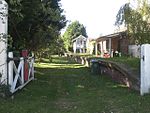Fring, Norfolk

Fring is a civil parish in the English county of Norfolk. It covers an area of 6.93 km2 (2.68 sq mi) and had a population of 94 in 41 households at the 2001 census. The population remained less than 100 at the 2011 Census and was included in the civil parish of Sedgeford. For the purposes of local government, it falls within the district of King's Lynn and West Norfolk. There is a small cluster of buildings located along Fring road consisting of Fring All Saints. The villages name means 'Frea's place'. In 1870–72 Fring was described as: "a parish in Docking district, Norfolk; 2¾ miles SW of Docking, and 2 ESE of Sedgeford r. station. Post town, Docking, under Lynn. Acres, 1,710. Real property, £2,065. Pop., 173. Houses, 37." Fring is the traditional source of the River Heacham and a (now) often dry lake bed of approximately one acre marks the point where a spring fed the river. (52°52'56.0"N 0°34'48.4"E).
Excerpt from the Wikipedia article Fring, Norfolk (License: CC BY-SA 3.0, Authors, Images).Fring, Norfolk
Bircham Road, King's Lynn and West Norfolk Fring
Geographical coordinates (GPS) Address Nearby Places Show on map
Geographical coordinates (GPS)
| Latitude | Longitude |
|---|---|
| N 52.881562 ° | E 0.581074 ° |
Address
Bircham Road
Bircham Road
PE31 6SH King's Lynn and West Norfolk, Fring
England, United Kingdom
Open on Google Maps











